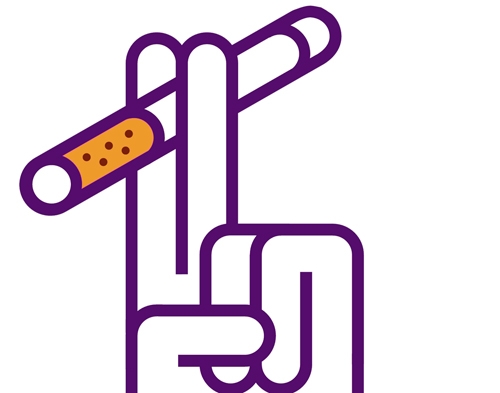Why Nevadans have quit quitting cigarettes

The decline in smoking has smoldered out. In the 40 years since cigarette ads were banished from television and radio – and, more recently, billboards — the U.S. smoking rate fell from 37 percent to 21 percent, according to the Centers for Disease Control and Prevention.
However, that 21 percent — which also is Nevada’s current smoking rate — has held since 2005 and shows no sign of falling further.
In Nevada alone each year, tobacco is directly responsible for 3,300 deaths, $565 million in health care costs and $903 million in productivity losses, according to the Campaign for Tobacco-Free Kids, a nonprofit lobbying group based in Washington, D.C.
"It’s probably a combination of factors that have gotten us to this plateau," said Christopher Roller, spokesman for the American Heart Association Nevada.
One factor remains tobacco advertising. Cigarette manufacturers invest heavily in magazine ads, retail and bar displays, and concert sponsorships and nightclub promotions during which they distribute free samples. Big tobacco’s annual marketing budget for Nevada is $113.8 million, according to the Campaign for Tobacco-Free Kids.
"Cigarette companies are very good at being creative and finding ways to get around the restrictions and still target their main audience, which is young people — replacement smokers," Roller said.
According to a study published in the Archives of Pediatrics and Adolescent Medicine in 2006 and not replicated since, exposure to tobacco messages in the media "more than doubles" the odds that children younger than 18 will smoke. (Currently, according to the Campaign for Tobacco-Free Kids, 2,800 Nevadans younger than 18 become new daily smokers each year.)
Last year, the Family Smoking Prevention and Tobacco Control Act gave the Food and Drug Administration additional authority to regulate tobacco advertising that may appeal to young people.
"It has been very helpful in restricting brightly colored ads and flavored cigarettes," Roller said, "but they’ll still find a way to get their message through."
Anti-smoking groups also cite as a contributing factor cuts in state-funded tobacco prevention and control programs such as the Fund For a Healthy Nevada, which paid for anti-smoking ads out of the 1998 Tobacco Master Settlement Agreement with the four largest U.S. cigarette companies. In 1999, before its implementation, Nevada’s high school smoking rate was 33 percent, according to the CDC. By 2009, it had plummeted to 14 percent.
"It worked," said Maria Azzarelli, tobacco control coordinator at the Southern Nevada Health District. "When you increase funding for anti-tobacco programs, smoking decreases."
After several rounds of budget cuts in the state Legislature, the Fund for a Healthy Nevada — which at one point provided $7 million per year — was slashed to zero in 2009. Not coincidentally, according to the experts interviewed, Nevada’s high school smoking rose from 14 percent in 2009 to 17 percent in 2010.
"They don’t know any better, they’re teenagers," said Amy Beaulieu, director of tobacco control policy for the American Lung Association of Nevada, which gives the Silver State "F’s" in a new report evaluating state anti-tobacco funding and smoking cessation success.
"They see people smoking around them, and all of these images of how cool it seems, and they need to be educated to resist that," Beaulieu said.
Last March, the Health District received a $14.6 million grant from the CDC to resume that resistence. Of this money, $5 million goes toward Health District media campaigns; the rest is divided primarily among the Nevada Tobacco Users Hotline for counseling; the American Lung Association for policy initiatives and youth classes; the Clark County School District for anti-tobacco educational programs; the Nevada Cancer Institute for worksite-based smoking cessation programs and the University of Nevada, Las Vegas to create smoke-free campuses across Clark County.
"It’s a tremendous amount of money," Azzarelli said. "But it runs out in March of 2012. What’s going to happen after that?"
Sen. Sheila Leslie, D-Reno, is reportedly hoping to answer that question with a bill that will raise the tax on a pack of cigarettes from 80 cents to $2. Anti-tobacco groups are asking that a portion of the estimated $80 million in revenue be used for tobacco control. (According to an American Lung Association of Nevada poll of 800 registered Nevada voters, 73 percent favor raising the tax and 75 percent favor using some of the revenue to fund anti-smoking programs.)
"We’re only asking for 10 percent," Beaulieu said. "They can use the rest of the 80 million any way they want — to fill the state budget gap or towards education."
The Nevada Legislature reconvenes on Feb. 7.
The other factor preventing a further smoking decline, so say anti-tobacco groups, is the influence of celebrities who light up on the small and big screens. Advertising may be banned from TV, but smoking on it seems as prevalent as ever.
"If you look at something like ‘Jersey Shore,’ everybody’s smoking," Azzarelli said. "And in all of these cooking shows, you’ll see the chefs smoking."
Although no organization tracks the frequency of smoking on TV, the CDC reports that nearly half of the top-grossing films of 2009 featured smoking. However, it also reports a 49 percent decline in the number of smoking scenes in films from 2005 to 2009.
"That’s encouraging, at least," Azzarelli said. "We have science and the facts on our side. So hopefully, we can take care of this issue and keep moving forward, because tobacco use has a devastating financial and health toll on our state."
Contact reporter Corey Levitan at clevitan@ reviewjournal.com or 702-383-0456.